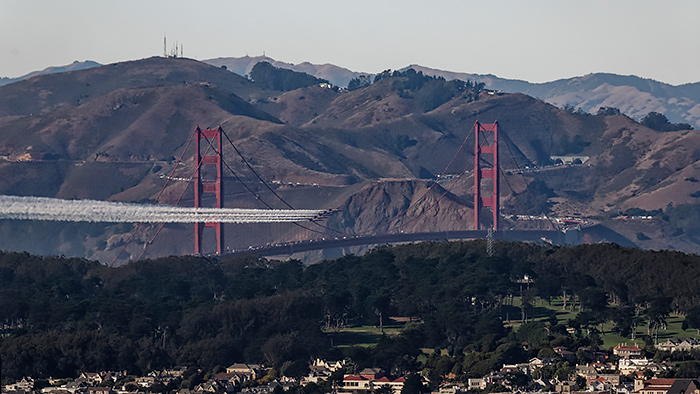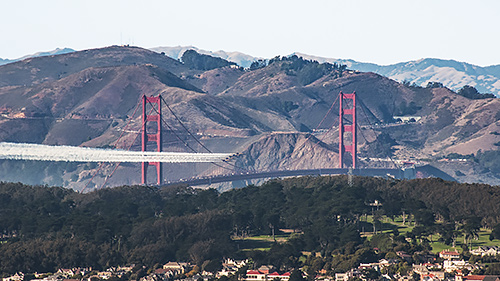Photo Corners headlinesarchivemikepasini.com
![]()
A S C R A P B O O K O F S O L U T I O N S F O R T H E P H O T O G R A P H E R
![]()
Enhancing the enjoyment of taking pictures with news that matters, features that entertain and images that delight. Published frequently.
Angels At The Gate




9 October 2018
We know better than to watch the Blue Angels perform over San Francisco Bay from Twin Peaks. The little planes are just too far away to see with the naked eye.

Blue Angels at the Golden Gate. Sunday, October 7. They are descending just south of the bridge.
The best place to view the show is from the Marina Green and Fort Mason. You won't miss much there and you'll even be able to make out a pilot or two braced in their canopy as they fly by close to the water.
What you can see from Twin Peaks is the big picture. The "parabolic curves" (as one father described them to his child) they draw in the sky with biodegradable, paraffin-injected exhaust in three colors.
These birds can fly faster than the speed of sound, known affectionately as mach. But they don't want to shatter any windows around here so they top out at a bit above 0.9 mach or 700 mph and as slow as 120 mph.
The pilots counter the G-forces they experience at those high speeds with muscle contractions and the hick maneuver instead of inflatable G-suits because 1) they know when in the routine the G-forces will be affecting them and 2) it isn't safe to handle the plane with such precision in those suits. Without one or the other, they'd pass out.
And when we say "precision," we mean they fly as close as 18 inches away from each other.

Detail. All six McDonnell Douglas F/A-18 Hornets can be seen in this crop.
We had a polarizer on our 18-200mm zoom, cranked out to 200mm for this shot, which captured more than you can otherwise see from that distance.
With the polarizer, we usually shoot at ISO 400 and that let us use f11 at 1/250 second. With Vibration Reduction active, we had no problem getting a sharp image.
It's our favorite from the show itself. And with a little help from Adobe Camera Raw in Photoshop CC, it came alive.
We used Clarity and the Dehaze sliders first, then dragged the Blacks and Whites sliders to extend the tonal range before adjusting the Shadows and Highlights sliders. To compensate for the yellowish tint of the polarizer, we adjusted the White Balance temperature as well. Oh, and we used Adobe's Landscape color profile.
We have to confess we're no expert on the Blue Angels. We learned what we've told you watching a telecast of the Saturday show, in fact.
Those were the best seats we've ever had.
Update (11 Oct.): Notice anything different? We replaced the images today with improved edits. The original edit (shown below for reference) brought out too much shadow detail at the expense of the overall tonality of the image.

So we edited the image in DxO PhotoLab before bringing it back into Photoshop for a slight tweak or two with Camera Raw and to export the various versions used in this story.
Sometimes looking at something with a different editor helps. And in this case Photo Lab helped a lot.